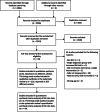Evidence on physical activity and falls prevention for people aged 65+ years: systematic review to inform the WHO guidelines on physical activity and sedentary behaviour
- PMID: 33239019
- PMCID: PMC7689963
- DOI: 10.1186/s12966-020-01041-3
Evidence on physical activity and falls prevention for people aged 65+ years: systematic review to inform the WHO guidelines on physical activity and sedentary behaviour
Abstract
Background: Exercise prevents falls in older adults. Regular updates of estimated effects of exercise on falls are warranted given the number of new trials, the increasing number of older people globally and the major consequences of falls and fall-related injuries.
Methods: This update of a 2019 Cochrane Review was undertaken to inform the World Health Organization guidelines on physical activity and sedentary behaviour. Searches were conducted in six databases. We included randomised controlled trials evaluating effects of any form of physical activity as a single intervention on falls in people aged 60+ years living in the community. Analyses explored dose-response relationships. The certainty of the evidence was assessed using Grading of Recommendations Assessment, Development and Evaluation (GRADE).
Results: This review included 116 studies, involving 25,160 participants; nine new studies since the 2019 Cochrane Review. Exercise reduces the rate of falls by 23% (pooled rate ratio (RaR) 0.77, 95% confidence interval (CI) 0.71 to 0.83, 64 studies, high certainty evidence). Subgroup analysis showed variation in effects of different types of exercise (p < 0.01). Rate of falls compared with control is reduced by 24% from balance and functional exercises (RaR 0.76, 95% CI 0.70 to 0.82, 39 studies, high certainty evidence), 28% from programs involving multiple types of exercise (commonly balance and functional exercises plus resistance exercises, RaR 0.72, 95% CI 0.56 to 0.93, 15 studies, moderate certainty evidence) and 23% from Tai Chi (RaR 0.77, 95% CI 0.61 to 0.97, 9 studies, moderate certainty evidence). The effects of programs that primarily involve resistance training, dance or walking remain uncertain. Interventions with a total weekly dose of 3+ h that included balance and functional exercises were particularly effective with a 42% reduction in rate of falls compared to control (Incidence Rate Ratio (IRR) 0.58, 95% CI 0.45 to 0.76). Subgroup analyses showed no evidence of a difference in the effect on falls on the basis of participant age over 75 years, risk of falls as a trial inclusion criterion, individual versus group exercise, or whether a health professional delivered the intervention.
Conclusions: Given the strength of this evidence, effective exercise programs should now be implemented at scale.
Keywords: Accidental falls; Aged; Exercise; Older adults; Physical activity.
Conflict of interest statement
The authors declare that they have no competing interests.
Figures
Similar articles
-
Exercise for preventing falls in older people living in the community.Cochrane Database Syst Rev. 2019 Jan 31;1(1):CD012424. doi: 10.1002/14651858.CD012424.pub2. Cochrane Database Syst Rev. 2019. PMID: 30703272 Free PMC article.
-
Exercise for preventing falls in older people living in the community: an abridged Cochrane systematic review.Br J Sports Med. 2020 Aug;54(15):885-891. doi: 10.1136/bjsports-2019-101512. Epub 2019 Dec 2. Br J Sports Med. 2020. PMID: 31792067
-
Environmental interventions for preventing falls in older people living in the community.Cochrane Database Syst Rev. 2023 Mar 10;3(3):CD013258. doi: 10.1002/14651858.CD013258.pub2. Cochrane Database Syst Rev. 2023. PMID: 36893804 Free PMC article. Review.
-
Interventions for preventing falls in people with multiple sclerosis.Cochrane Database Syst Rev. 2019 Nov 28;11(11):CD012475. doi: 10.1002/14651858.CD012475.pub2. Cochrane Database Syst Rev. 2019. PMID: 31778221 Free PMC article.
-
Social Dancing and Incidence of Falls in Older Adults: A Cluster Randomised Controlled Trial.PLoS Med. 2016 Aug 30;13(8):e1002112. doi: 10.1371/journal.pmed.1002112. eCollection 2016 Aug. PLoS Med. 2016. PMID: 27575534 Free PMC article. Clinical Trial.
Cited by
-
Community-Based Peer-Led Intervention for Healthy Ageing and Evaluation of the 'HAPPY' Program.J Nutr Health Aging. 2021;25(4):520-527. doi: 10.1007/s12603-021-1606-6. J Nutr Health Aging. 2021. PMID: 33786571 Free PMC article.
-
Systematic review of adherence to technology-based falls prevention programs for community-dwelling older adults: Reimagining future interventions.PLOS Digit Health. 2024 Sep 3;3(9):e0000579. doi: 10.1371/journal.pdig.0000579. eCollection 2024 Sep. PLOS Digit Health. 2024. PMID: 39226315 Free PMC article.
-
Is it a Macho Thing? Older Adults' Perceptions of Gender Differences inFall Prevention Class Participation.J Appl Gerontol. 2022 Aug;41(8):1952-1959. doi: 10.1177/07334648221095623. Epub 2022 May 11. J Appl Gerontol. 2022. PMID: 35543184 Free PMC article.
-
'Maintaining balance in life'-exploring older adults' long-term engagement in self-managed digital fall prevention exercise.Eur Rev Aging Phys Act. 2023 Jul 18;20(1):12. doi: 10.1186/s11556-023-00322-7. Eur Rev Aging Phys Act. 2023. PMID: 37464299 Free PMC article.
-
Bed-Exit Behavior Recognition for Real-Time Images within Limited Range.Sensors (Basel). 2022 Jul 23;22(15):5495. doi: 10.3390/s22155495. Sensors (Basel). 2022. PMID: 35898000 Free PMC article.
References
-
- Campbell AJ, Borrie MJ, Spears GF, Jackson SL, Brown JS, Fitzgerald JL. Circumstances and consequences of falls experienced by a community population 70 years and over during a prospective study. Age Ageing. 1990;19(2):136–141. - PubMed
-
- Tinetti MESM, Ginter SF. Risk factors for falls among elderly persons living in the community. N Engl J Med. 1988;319(26):1701–1707. - PubMed
-
- Stenhagen M, Ekstrom H, Nordell E, Elmstahl S. Accidental falls, health-related quality of life and life satisfaction: a prospective study of the general elderly population. Arch Gerontology Geriatr. 2014;58(1):95–100. - PubMed
-
- Yardley LSH. A prospective study of the relationship between feared consequences of falling and avoidance of activity in community-living older people. Gerontologist. 2002;42(1):17–23. - PubMed
Publication types
MeSH terms
LinkOut - more resources
Full Text Sources
Medical
Miscellaneous




